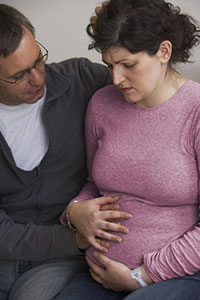Signs of Labor
What Are the Signs of Labor?
 When you go into labor, you’ll start to feel strong contractions, which may be described as cramping that begins in your back and moves to the front of your abdomen. During a contraction, the muscles on the top of your uterus tighten up and the muscles on the bottom relax and stretch to help push your baby out.
When you go into labor, you’ll start to feel strong contractions, which may be described as cramping that begins in your back and moves to the front of your abdomen. During a contraction, the muscles on the top of your uterus tighten up and the muscles on the bottom relax and stretch to help push your baby out.
Signs of labor
- Contractions get stronger and more painful instead of weaker. You’ll probably feel them throughout your whole uterus.
- Contractions are regular, about every 5 to 10 minutes, and are getting closer together.
- You have pink-colored or blood-streaked fluid from your vagina.
- Your water breaks. It may be a gush or a slow trickle of clear fluid from your vagina.
Signs of false labor
- Contractions aren’t regular or strong.
- Contractions occur only in your lower uterus.
- Contractions go away when you walk, lie down or change position.
- Contractions go away after drinking fluids.
How do I time my contractions?
Begin timing your contractions once they become uncomfortable. Time your contractions using the following measures:
- The length of each contraction from its start to its finish
- How far apart the contractions are—the time between the start of one contraction and the start of the next contraction
If it is your first delivery, call the office once the contractions are consistently every four to five minutes and increase in intensity for an hour. If this is not your first delivery, discuss with your physician at which time you should call the office during your labor.
Early labor at home
Latent labor (when the cervix is dilated from 0–4 cm) is a very unpredictable phase. For some women, it is a short interval, and for others, it can be very prolonged. Whenever possible, it's best to do the early phase of labor at home where you are most comfortable. Laboring at home also ensures the likelihood that once you arrive at the hospital, you will be in active labor and unlikely to be sent back home. While at home:
- Rest as much as possible. Try to stay in bed until it is no longer comfortable.
- Ease your discomfort by walking, taking a warm shower or putting a warm (not hot) heating pad on your lower abdomen or back.
- Stay hydrated. If you become dehydrated, it can adversely affect the progression of your labor. Try to drink one glass of fluid with sugar every hour, such as Gatorade, lemonade or apple juice. If you are well hydrated, your urine will be pale yellow to clear.
- Eat foods that are easily digested, such as flavored gelatin, popsicles, soup, bagels, fruit and yogurt. If you feel nauseated, only drink liquids.
Warning signs in pregnancy
Whether in labor or at any time during your pregnancy, call your health care provider or clinic right away if you notice any of these signs:
- Fluid from your vagina, with or without contractions
- Bleeding heavy enough that you need a sanitary pad
- Decreased movement by your baby
- Severe pelvic pain or persistent pain in your abdomen or back
- Fever at or above 100.4 F
- Sudden swelling to your legs, face, hands or eyes or sudden weight gain of two to three pounds within a few days
- Severe headache that does not resolve with rest or Tylenol, especially if accompanied by vision changes and swelling
- Sudden onset of vision changes (blurring, double vision, seeing spots)
- Persistent nausea or vomiting more than three times daily or inability to tolerate food or liquids for two days
- Inability to have a bowel movement after three to four days, especially if accompanied with severe pelvic pain
- Redness and swelling to your calf or leg that causes pain with walking
- Pain or difficulty urinating, especially if accompanied by blood in the urine or a scant amount of urine output for the day
- Fainting episodes or persistent dizziness
- All-over itching with or without a rash, especially if accompanied by dark urine or jaundice
- If you're worried or have any doubts
